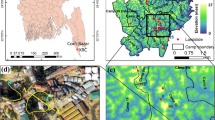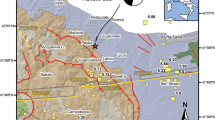Abstract
On 24 January 2012, a fatal landslide with an estimated volume of 3 Mm3 hit villagers and infrastructure in the Tagali Valley, Southern Highlands Province, Papua New Guinea (PNG). Although a moderate event by PNG standards, the associated human casualties and infrastructure destruction give a human as well as a scientific need to review the potential causes for the event. PNG experiences numerous landslides annually, most of which are trigged either by rainfall events or seismic activity. Here, we review the short-term rainfall patterns leading up to the slope failure at Tumbi Quarry and compare the rainfall accumulations obtained over durations of 30, 60 and 90 days prior to the landslide, with comparable rainfall accumulations obtained for other failures observed in PNG over a 12-year period. Additionally, a review of long-term rainfall over a period of 6 months prior to the failure is completed as well as an assessment of seismic activity. Based on our analysis, we believe a seismic trigger to be very unlikely, while the increase in rainfall in the 2 weeks prior to the failure in conjunction with a high-intensity rainfall event at the end of October 2011 could have had a greater influence in enhancing rather than restraining slope failure. This, in addition to natural denudational processes, geological structure and the anthropogenic activity in the vicinity of the landslide, could all have served to affect slope stability.









Similar content being viewed by others
References
Adler RF, Huffman GJ, Chang A, Ferraro R, Xie P-P, Janowiak J, Rudolf B, Schneider U, Curtis S, Bolvin D, Gruber A, Susskind J, Arkin P, Nelkin E (2003) The Version 2 Global Precipitation Climatology Project (GPCP) monthly precipitation analysis (1979–present). J Hydrometeorol 4:1147–1167
Ancey C (2007) Plasticity and geophysical flows: a review. J Non-Newtonian Fluid Mech 142:4–35
Anton L, Gibson G (2007) Earthquake hazard in Papua New Guinea: problems and the way forward. Proceedings of Australian Earthquake Engineering Society, Wollongong. http://www.aees.org.au/Proceedings/2007_Papers/10_Anton,_Lawrence.pdf. Accessed 23 Feb 2012
Blong RJ (1986) Natural Hazards in the Papua New Guinea Highlands. Mt Res Dev 6(3):233–246
Bryan JE, Shearman PL (comps.) (2008) Papua New Guinea Resource Information System Handbook, 3rd ed., University of Papua New Guinea, Port Moresby
D’Appolonia S.p.A (2011a) Environmental and social compliance monitoring: Papua New Guinea LNG Project: Site Visit: March, 2011, D’Appolonia S.p.A, Genova, Italy, 22 p. http://pnglng.com/media/pdfs/quarterly_reports/IESC-Report-March2011.pdf. Accessed 15 Feb 2012
D’Appolonia S.p.A (2011b) Environmental and social compliance monitoring: Papua New Guinea LNG Project: Site Visit: November, 2011, D’Appolonia S.p.A, Genova, Italy, 48 p. http://pnglng.com/media/pdfs/quarterly_reports/IESC-Report-November2011.pdf. Accessed 15 Feb 2012
Davies HL (2012) The geology of New Guinea—the cordilleran margin of the Australian continent. Episodes 35(1):87–102
Findlay RH (2003) Collision tectonics of northern Papua New Guinea: key field relationships demand a new model. Geol Soc Am Spec Pap 372:291–307
Greenbaum D, Tutton M, Bowker MR, Browne TJ, Buleka J, Greally KB, Kuna G, McDonald AJW, Marsh SH, Northmore KJ, O’Connor EA, Tragheim DG (1995) Rapid methods of landslide hazard mapping. Papua New Guinea case study: British Geological Survey Technical Report WC/95/27., pp 112
Griffiths JS, Hutchinson JN, Brunsden D, Petley DJ, Fookes PG (2004) The reactivation of a landslide during the construction of the Ok Ma tailings dam, Papua New Guinea. Q J Eng Geol Hydrogeol 37:173–186
ESSO Highlands Limited (2010) Papua New Guinea LNG Project: Tumbi Quarry (QA1) resettlement action plan PGHU-EH-SPzzz-410003. http://pnglng.com/media/pdfs/committment/PGHUEHSPZZZ410003_Tumbi_Quarry__QA_1__RAP_Rev_0_Website_48956.pdf. Accessed 01 Mar 2012
Hill KC, Gleadow AJW (1989) Uplift and thermal history of the Papuan Fold Belt, Papua New Guinea: apatite fission track analysis: Australian Journal of Earth Sciences. Int Geosci J Geol Soc Aust 36(4):515–539
Hill KC, Lucas K, Bradley K (2010) Structural styles in the Papuan Fold Belt, Papua New Guinea: constraints from analogue modelling. In: Goffey GP, Craig J, Needham T, Scott R (eds) Hydrocarbons in contractional belts, vol 348. Geological Society, London, pp 33–56, Special Publications
Hovius NH, Stark CP, Tutton MA, Abbott LD (1998) Landslide-driven drainage network evolution in a pre-steady-state mountain belt: Finisterre Mountains, Papua New Guinea. Geology 26(12):1071–1074
Huffman GJ, Adler AF, Bolvin DT, Gu G, Nelkin EJ, Bowman KP, Hong Y, Stocker EF, Wolff DB (2007) The TRMM Multisatellite Precipitation Analysis (TMPA): quasi-global, multiyear, combined-sensor precipitation estimates at fine scale. J Hydrometeorol 8:38–55
James JM (1980) Water chemistry of the Atea Kananda and related drainage area. Helictite 18:8–25
James JM (2006) Giant dolines of the Muller Plateau, Papua New Guinea. Speleogenesis Evol Karst Aquifers 4(1):1–11
King J, Loveday I, Schuster RL (1989) The 1985 Bairaman landslide dam and resulting debris flow, Papua New Guinea. Q J Eng Geol 22:257–270
Kuna G (1998) The impact of landslides on national highways in the Highlands Region. Papua New Guinea Geological Survey Technical Note TN 8/98, Port Moresby
Löffler E (1977) Geomorphology of Papua New Guinea. CSIRO, ANU Press, Canberra
McAlpine JR, Keig G, Falls R (1983) Climate of Papua New Guinea. Commonwealth scientific and industrial research organization, Melbourne
Meunier P, Hovius N, Haines AJ (2007) Regional patterns of earthquake-triggered landslides and their relation to ground motion, Geophysical Research Letters 34. doi:10.1029/2007GL031337
NEIC (2012) Preliminary determination of epicenters monthly listing, February 2012: U.S. Department of the Interior. http://earthquake.usgs.gov/earthquakes/eqarchives/epic/. Accessed 12 Jul 2012
Pain CF, Bowler JM (1973) Denudation following the November 1970 earthquake at Madang, Papua New Guinea. Zeitschrift fur Geomophologie 18:92–104
Peart M (1991) The Kaiapit Landslide: events and mechanisms. Q J Eng Geol Hydrogeol 24:399–411
Petley D (2012) The landslide blog. Breaking news—an image from the Tumbi Quarry site before the landslide. http://blogs.agu.org/landslideblog/2012/03/07/breaking-news-an-image-of-the-tumbi-quarry-site-before-the-landslide/. Accessed 10 Mar 2012
Stead D (1990) Engineering Geology in Papua New Guinea. Eng Geol 29:1–20
Papua New Guinea National Disaster Centre (NDC) Technical Assessment Team (2012) Tumbi (Lanjako/Nogoli Perepa) council ward in the Komo LLG Assessment Form, Port Moresby. http://www.pacificdisaster.net/pdnadmin/data/original/PNG_2012_LS_assessmnt_rprt.pdf. Accessed 01 Mar 2012
Tutton MA, Browne TJ (1994) A review of damage caused by the 1993 Finisterre Range earthquakes, Papua New Guinea, Proceedings of the PNG Geology, Exploration and Mining Conference, 33–41
Walker R (2005) Lihir suffers landslide (October 24, 2005), The Northern Miner: The Global Mining Newspaper. www.northernminer.com/news/lihir-suffers-landslide/1000198525. Accessed 19 Nov 2011
Williams PM (1972) Morphometric analysis of polygonal karst in New Guinea. Geol Soc Am Bull 83:761–796
Wilson C (2012) Papua New Guinean landslide survivors wait in vain for justice. IPS Inter Press Service News Agency. http://www.ipsnews.net/2012/03/papua-new-guinean-landslide-survivors-wait-in-vain-for-justice/. Accessed 10 Mar 2012
Wilson RC, Keefer DK (1985) Predicting aerial limits of earthquake-induced landsliding. In: Ziony JI (ed) Evaluating earthquake hazards in the Los Angeles region—an earth-science perspective, USGS Professional Paper 1360, United States Government Printing Office, Washington, pp 316–345
Acknowledgments
This research was jointly supported by the UK Meteorological Office, University of Leicester and University of Papua New Guinea. We thank Elizabeth Michael, Principal Engineering Geologist at the Department of Mineral Policy and Geohazards Management, Papua New Guinea who kindly provided original photographs and satellite imagery of the landslide for this analysis. Analyses conducted in this paper were produced with the Giovanni online data system, developed and maintained by the NASA GES DISC.
Author information
Authors and Affiliations
Corresponding author
Rights and permissions
About this article
Cite this article
Robbins, J.C., Petterson, M.G., Mylne, K. et al. Tumbi Landslide, Papua New Guinea: rainfall induced?. Landslides 10, 673–684 (2013). https://doi.org/10.1007/s10346-013-0422-4
Received:
Accepted:
Published:
Issue Date:
DOI: https://doi.org/10.1007/s10346-013-0422-4




